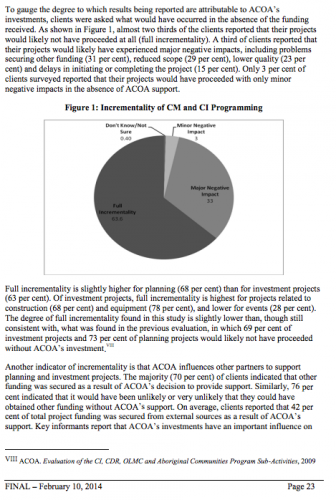Executive Summary
ACOA’s Community Mobilization (CM) and Community Investment (CI) sub-programs are part of the Agency’s Community Development (CD) program. Through its CD program, ACOA works with communities and entrepreneurs to stimulate economic growth, improve infrastructure and develop opportunities in local economies, with the desired outcome of creating dynamic and sustainable Atlantic communities. In support of this outcome, the CM sub-program supports the mobilization of key stakeholders for the planning of economic development initiatives, while the CI subprogram invests in critical economic development infrastructure and other initiatives that support economic development outcomes.
CM and CI programming is delivered using a decentralized model, involving all ACOA regional and district offices working in close partnership with a variety of government and non-governmental stakeholders. Two main transfer payment programs are used: The Innovative Communities Fund (ICF) and the business support element of the Business Development Program (BDP). Overall, an average of approximately $103 million per year is expended through CM and CI programming, representing 28 per cent of ACOA’s total expenditures.
The purpose of this evaluation is to assess the relevance and performance of CM and CI programming and to fulfill Government of Canada accountability requirements. The evaluation covers the four-year period from fiscal year 2008-2009 to 2011-2012. Although CM and CI are separate sub-programs, they have been evaluated together to acknowledge the complementarity between economic development planning and investments and to address challenges in how the sub-programs are differentiated in administrative data. This is in keeping with the terms of reference for the study, which were approved by ACOA’s executive committee in June 2012.
The evaluation methodology included 13 case studies, 71 key informant interviews, a client survey with an overall response rate of 49 per cent, a document and literature review, and a detailed analysis and categorization of over 1,000 projects. Close to 300 individuals provided their knowledge and insight to this study. Given that operational funding to regional economic development organizations (REDOs) across Atlantic Canada was ceased as of May 2013, only existing data related to REDOs was considered in this evaluation. Evaluation findings are based on a high level of convergence of multiple lines of evidence and are deemed reliable and valid within the context of the study limitations.
Download the report here
Table of Contents
1. Introduction
Evaluation Overview
1.2 Evaluation Design and Methodology
1.3 Evaluation Limitations, Mitigating Measures and Strengths
2. Profile of the Community Mobilization and Community Investment Sub-programs
2.1 Context
2.3 Program Theory
2.3.1 Program Logic Model
2.3.2 Other Influential Factors
2.4 Program Accountability and Governance
2.5 Expenditure Profile
2.5.1 Proportion of Overall Agency Expenditures
2.5.2 CM and CI Expenditures
2.6 Project Profile
3. Findings: Relevance
3.1 Continued Need for Programming
3.1.1 Programming-Related Needs
3.1.2 Awareness of and Responsiveness to Changing Needs
3.1.3 Extent of Overlap, Duplication and Complementarity with Other Programming
3.2 Alignment with ACOA and Government-wide Priorities and Strategies
3.3 Alignment with Federal Roles and Responsibilities
4. Findings: Performance – Effectiveness
4.1 Incrementality
4.2 Achievement of Expected Results
4.2.1 Planning Projects
4.2.2 Investment Projects
4.3 Unintended Outcomes of Planning and Investment Programming
4.4 Roadmap for Linguistic Duality Initiatives: Achievement of Outcomes
4.5 Overall Achievement of CED impacts
4.6 Barriers to the Achievement of Planning and Investment Outcomes
4.7 Lessons Learned and Best Practices in Delivery
4.8 Adequacy of Performance Measurement
5. Findings: Performance – Efficiency and Economy
5.1 Efficient Utilisation of Resources
5.1.1. Delivery Costs
5.1.2 Mechanisms that Support Efficient and Economical Delivery
5.2 Alternative Modes of Delivery for Increasing Efficiency and Economy
6.0 Conclusions and Recommendations
Format
Source





